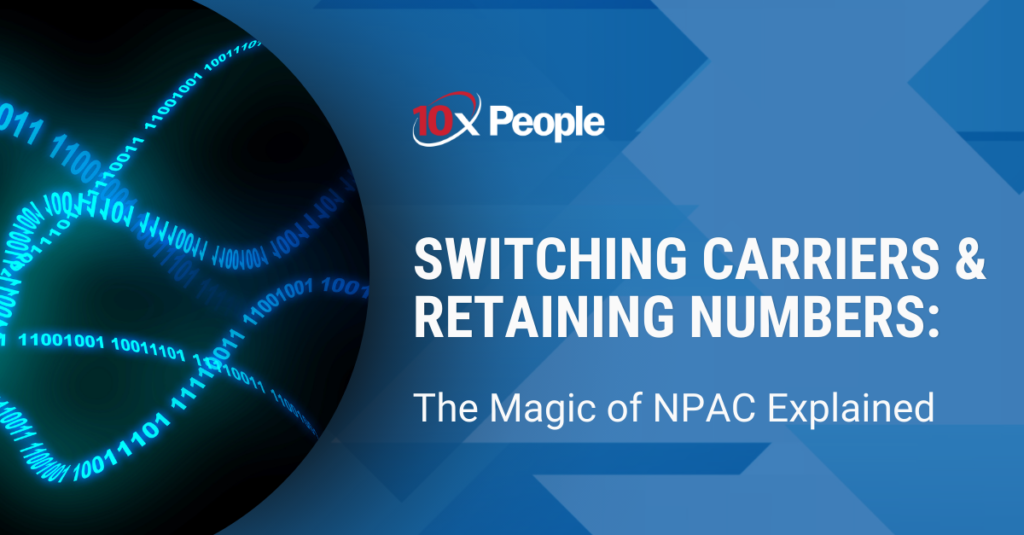
Ever wondered about the magic that happens behind the scenes when you switch your phone carrier but get to keep your precious digits? To find the answer, you’ll need to dive into the world’s largest number portability registry: the Number Portability Administration Center (NPAC). Overseen by the Federal Communications Commission, NPAC is where phone numbers find new homes without you even knowing about the complex behind-the-scenes process. The Federal Communications Commission (FCC) mandated Local Number Portability (LNP) as part of the Telecommunications Act of 1996 and the service providers fund and manage the contract.
In this blog, we’ll explain what NPAC does, why it was founded, and the important role it plays in telephone number switching so you can better understand the numbering magic that takes place behind the scenes.
What is NPAC?
The NPAC (Number Portability Administration Center) acts as a centralized database and system, facilitating the smooth transfer of service associated with phone numbers in the United States across diverse telecommunications service providers nationwide. Serving as the foundation for number portability, this system enables individuals and businesses to retain their current phone numbers seamlessly when transitioning from one carrier to another.
Established in 1996 as part of the Telecommunications Act of 1996 — which provided consumers the right to keep their phone number even when switching service providers — NPAC includes approximately 1 billion telephone numbers managed by approximately 1,600 service providers. The NPAC makes LNP work for all U.S. telephone numbers, including wireless, VOIP and wireline numbers. The importance of the Telecommunications Act of 1996 and the NPAC’s responsibility in facilitating service provider switching is that it allows individuals and businesses to shop around for the best cost savings and advantages amongst landline, VOIP, or mobile operators, creating competition in the market and unhandcuffing users to a certain service provider just for the sake of keeping their phone numbers. Today, with our numbers tied to everything from our bank accounts to social media, the ability to port phone numbers is increasingly important.
When it comes to the process of service provider switching, the NPAC can be thought of as the master of all switchboards, ensuring that when you decide to jump ship to a new carrier, your number doesn't get lost in the digital Bermuda Triangle.
Learn how it all comes together below.
Number Portability 101: How the NPAC Works Magic
Let's break these digits down for you. When you decide it's time to part ways with your old carrier, the NPAC steps in like a digital moving company for your phone number. First, a provider tells NPAC they have a customer that wants to port with them. Then, the old provider is notified and has a chance to say, “Woah, not so fast!” The NPAC confirms your identity and that both carriers are OK with completing your port. Behind the scenes, here’s what’s really happening:

Porting
This is the fancy term for switching carriers while keeping your number. Think of it as your phone number moving to a new network.
Mobile Versus Landline Portability
Move across town, keep your number. It’s that easy. Local Number Portability provides you flexibility for switching the service on the numbers you want to keep no matter which service provider you want to use, provided the new service provider is ready and open for business. You can take your mobile number anywhere, while your landline must stay in the same area of town.
Porting timeframe
Usually, it takes about one to three business days for a landline number to settle into its new home. Even better? Wireless numbers can be ported in a few minutes unless there are some discrepancies or communication issues between the two carriers during the porting process. Think of it as jet lag for your phone number (but way less dramatic). The rule of thumb for wireless number porting is less than one hour once a request is made.
The carriers check the paperwork, NPAC double-checks that the carrier it is porting from and to is correct, makes sure you're free from any entanglements, and then, voila! Your number gets a golden ticket to its new carrier. It's like a backstage pass to the coolest telecom party in town and the NPAC is the bouncer ensuring only the legit numbers make it through.
Behind the scenes, NPAC also:
- Provides notification to your current carrier to help prevent number hijacking, ensuring your digits don't fall into the wrong hands.
- Informs everyone when you have moved, making sure you don’t miss any calls.
- Maintains a central database like a phonebook (remember those?) There is a separate NPAC for the United States and Canada.
10x People: Working Hand in Hand with NPAC
10x People, a pioneer and leader in LNP, provides cutting-edge software solutions for number porting. 10x People Founder and CEO Lisa Marie Maxson wrote the original LNP messaging interface specification that is still in use today in both the U.S. and Canada. Our xPort Local Service Management System is a cloud-based solution that receives real-time LNP port-corrected data broadcasts from all NPAC regions. Our nVentory solution offers an LNP gateway and integration with nPort SOA to simplify inventory updates. nPort SOA is a cloud-based LNP solution that allows you to port phone numbers quickly, easily and efficiently.
We have been developing and refining LNP processes for more than 10 years, ensuring a seamless transition for users and contributing to the longevity of phone numbers.
Connect with 10x People today to learn more about our modern workflow-based number portability platform and discover why a phone number inventory numbering system is important.